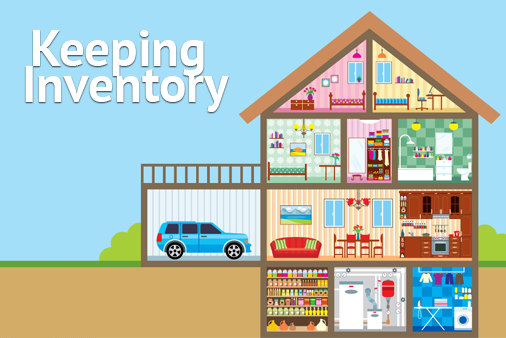Would you be able to remember all the possessions you have accumulated over the years if they were destroyed by a fire or other disaster?
Having an up-to-date home inventory will help you get your insurance claim settled faster, verify losses for your income tax return and help you purchase the correct amount of insurance.
Start by making a list of your possessions, describing each item and noting where you bought it and its make and model. Clip to your list any sales receipts, purchase contracts, and appraisals you have. For clothing, count the items you own by category (pants, coats, shoes, for example), making notes about those that are especially valuable. For major appliances and electronic equipment, record the serial numbers, which are usually found on the back or bottom.
- Don’t be put off!
If you are just setting up a household, starting an inventory list can be relatively simple. If you’ve been living in the same house for many years, however, the task of creating a list can be daunting. Still, it’s better to have an incomplete inventory than nothing at all. Start with recent purchases, then try to remember what you can about older possessions. - Big ticket items
Valuable items like jewelry, art work and collectibles may have increased in value since you received them. Check with your agent to make sure that you have adequate insurance for these items. They may need to be insured separately and it is important that your insurance company know about these items before there is a loss. - Take a picture
You can also take pictures of rooms and important individual items to have a visual record of your belongings. On the back of the photos, note what is shown and where you bought it or the make. Don’t forget things that are in closets or drawers. If you use your phone or a digital camera, you may also be able to add a description of the item when saving the photo. - Videotape it
Walk through your house or apartment videotaping and describing the contents. Or do the same thing using a tape recorder. This can be useful for items such as clothing or kitchenware. You can simply open a kitchen shelf or closet and describe the contents. For instance, in the kitchen, it would be sufficient to state that you have a set of dishes for 12 that includes a dinner plate, salad plate, etch with when and where it was purchased - Create a digital record
Use your computer or mobile device to make your inventory list. There are many software options and mobile apps that can help you create a room-by-room record of your belongings. To make creating your inventory as easy as possible, the I.I.I. offers free Web-based home inventory software, Know Your Stuff® – Home Inventory. The software includes secure online storage so you can access your inventory anywhere, anytime. You can also download the Know Your Stuff app in the iTunes App Store (or search for “iii inventory”) or fromGoogle Play. Information about your belongings can be entered either through the mobile app or online and your data will automatically synchronize between the two. All of your information will be kept in your personal, password protected account, on Amazon secure servers. And, like the online version, the Know Your Stuff® app is free of charge.
Storing your list
Regardless of how you do it (written list, photos, computer hard drive, flash-drive, or in the cloud), keep a record of your inventory. If it is a physical document, store it along with the receipts in your safe deposit box or at a friend’s or relative’s home. If it is a digital file, make sure to back it up and keep a copy on an external drive or online storage account. That way it will be easily available to give your insurance representative if your home is damaged. When you make a significant purchase, add the information to your inventory while the details are fresh in your mind.



